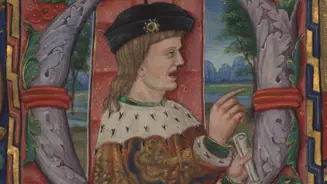Fact or Fiction: Was King Manuel I in Sintra when he learnt about the discovery of Brazil and the sea route to India?
31 Jul 2023
Many stories have taken place over the backdrop of Sintra, some based on fact, others merely fabrications that have gained ‘legs’ over the generations. In either case, the truth is that many of these tales have attracted the attention of those who live in, visit and study Sintra.
One of these tales involves King Manuel I. Legend has it that the king often went to the top of the Sintra hills in the hope of seeing the return of the Portuguese caravels that had sailed eastwards in 1497. It is also said that King Manuel I was in Sintra on the day he received two great pieces of news: the discovery of the sea route to India and the discovery of Brazil. Fact or fiction?
During the 15th century, kings spent long periods of time in this land. Hunting was one of the main attractions for the court in Sintra, but Lisbon's position as the centre of the kingdom's bureaucratic government also played a key role in this. The court began to confine its movements to a smaller and smaller radius around the main Portuguese city, seeking out the clean air of the mountains and beaches without venturing too far from Lisbon. It was at this time that King Manuel, who liked to spend long periods in Sintra, decided to renovate the palace, giving it new decorative elements that are still its hallmark today (the Hispano-Moresque tile coverings, for example) and adding imposing rooms (such as the Blazons Hall). By the end of his reign, the Palace of Sintra was one of the grandest palaces in Portugal.
King Manuel I did indeed spend a lot of time in Sintra. And the legends are true: the king did often go to the top of the mountain to see the caravels: 'When the King was widowed and temporarily retired to the Palace of Sintra, he often went up to the high cliffs in the hills. Through a window in the little chapel of Our Lady of Penha (the same chapel where King João II had camped for eleven days), he would immerse himself in the horizon, questioning, investigating, looking for the sails he had sent to the East...', writes the Count of Sabugosa (1903) in his work O Paço de Cintra. One curious fact is that King Manuel had the Royal Monastery of Our Lady of Pena built on this spot, though the 1755 earthquake left the monastery practically in ruins. In the 19th century, Ferdinand II – the king-consort married to Maria II – acquired the monastery and all the surrounding woodland with his personal fortune, creating the Park and the Palace of Pena.

Let us go back in time. We know that King Manuel I used to climb to the top of the Sintra hills in the hope of seeing the return of the caravels. But was he in the Palace of Sintra when he learnt of Vasco da Gama's arrival home?
'The Legends of India tell us that King Manuel was in Sintra in 1499 in the early evening and had just sat down to supper. Arthur Rodrigues, a merchant, married on Terceira Island, arrived at the palace and had a caravel about to leave for the Algarve. When he saw Vasco da Gama's ships entering the seas off that island, he raised an alarm without knowing where they were coming from. He passed them before they appeared and asked them where they were coming from. The ships replied that they were coming from India. He immediately followed in their wake to Lisbon, and when he reached Cascais he got into a small boat to go ashore, telling his son not to let anyone go ashore. He landed on the beach at Cascais and, because he had been told that the King was in Sintra, he went straight there to give him the news,' writes the Count of Sabugosa, quoting the work of the historian Gaspar Correia.
However, this author also mentions that there are other versions of this story in which Nicolau Coelho himself, Vasco da Gama's companion, arrived to tell the King the news. Regardless of these details, 'what seems certain is that the news was received in Sintra, where the King was located at that time of year,' says the Count of Sabugosa.
And did King Manuel I also hear the good news about the discovery of Brazil in Sintra?
The records prove that the king was at the Palace of Sintra when he learnt of this great discovery. They even mention a specific date: '(...) being with the new Queen and the Court in Sintra, on 31 July [1501] the king received the news of the arrival to Lisbon of the ships of Pedro Alvares Cabral, "who was very happy about his arrival, though with some sadness because of the people who had died on the ships that had sailed." This fleet brought him the news of the discovery of a new empire. Brazil had been discovered – Portugal had revealed a new continent to the world,' so reads the same work by the Count of Sabugosa, which here is based on Damião de Góis' chronicle of King Manuel I.
CONCLUSION: Fact.
